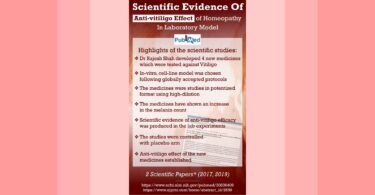Publisher – B. Jain Publishers Pvt. LTD. Delhi, India
Date of Publication – Reprint Edition 1995
Paperback edition – 234 pages
ISBN 81-7021-626-5
BOOK CODE B-2487
Note: This book includes a repertory of time modalities, by Dr. Ide, of Stettin, Germany, translated from the Berliner Zeitschrift Homöopathischer Ærzte, Band XXV, Hefte 3 and 4.” Originally published: Philadelphia : Boericke & Tafel, 1908.
ABSTRACT: This article deals with the construction and use of a lesser known repertory, The Clinic Repertory by Pw Shedd. This review will give you a clear view about how it is designed and how it is helpful.
This book was written based on the order of case taking, where the author gives more importance to the ailments and modalities followed by the sensation and location. The arrangement of the chapters in this book, make it helpful for bedside reference. The author gives more importance to the Pathological rubrics which are placed according to the location of the disease. We can consider this book as similar to BBCR. He also has a chapter called COMMON DISEASES in which the conditions in general are included as rubrics. The TIME REPERTORY part is arranged similar to KENT’S whereas in BBCR the time is more vague.
This repertory has a repertory of time modalities [by DR. IDE], intended for the use of the physician at the bedside, for rapid and accurate reportorial work. This book includes only remedies with greater and lesser importance [only two gradations], and all other remedies are omitted.
This was originally written in Germany and published in 1908 in Philadelphia by Boericke and Tafel. The Indian edition was published in English by B. Jain Publisher’s [p]Ltd. in 1995 and the last reprint edition was published in 2004.
PLAN AND CONSTRUCTION:
There is no particular philosophy here. The book has eight sections with many subsections for each. There are two sections which are on repertory, one is the first section and the other is the last section. Other sections are on therapeutics and relationships. The general alphabetic order is followed in each section including rubrics and sub rubrics in the repertory section. The typography used is CAPITAL and Roman.
The eight sections are:
The clinic repertory
Common diseases and conditions
Keynotes to fifty polychrests
Common sequences
Antidotes[dynamic]
Poisons: Antidotes
Appearance and aggravation of complaints according to time.
Index
The Clinic Repertory [pg 1-110]
The Clinic Repertory consists of 45 chapters. The first 7 chapters deal with ‘in general’ [weather and temperature, position and motion, sides, sensory stimulation, peculiar sensation, formication and numbness, alternation of complaints. The remaining chapters are arranged in anatomical order [starting from mind to generalities]. Each chapter’s name is placed in the centre in capital bold letters, and the rubrics and subrubrics are in bold letters. The total number of rubrics is 736 and subrubrics are 1008.
Common Diseases And Conditions [pg 110-116]
Common Diseases And Conditions: Tthis section consist of 16 common disease conditions and their nature with the corresponding remedies. All are arranged in alphabetical order. The typography followed is the same as in The Clinic Repertory: abscess, actinomycosis, anemia, anthrax, aphonia, carcinoma, chlorosis, cholera, rheumatism, scarlarina, septicaemia, tetanus, tumors, typhoid, uremia, variola.
Keynotes of Fifty Polychrests [pg 116-134]
Keynotes of Fifty Polychrests: This section is also arranged alphabetically starting from ACONITE and going to ZINC. Only the most important characteristic symptoms and important modalities are given by the author. This part is helpful for quick reference at the bed side.
For example LACHESIS- left sided, <in damp weather, <in evening and after sleep, <when at rest, pain > by establishment of a discharge, intolerance of touch, pressure, constriction, a hemic remedy-sepsis, disintegration, > in cold weather, menses commonly too short, scanty, climaxis.
Common Sequences [pg 134-136]
Common Sequences: This section consists of 128 remedies from ACONITE to ZINC with their “follows well” remedies in specific conditions and in general in the proper sequences. This part helps the physician to make the second prescription.
For example,
Aconitum: Arnica, Arsenicum album, [colic], Belladonna, Bryonia alba [cough], Ipecacuanha, Mercurius solubilis [dysentery], Sepia, Spongia tosta [cough].
Suphur: Calcarea carbonicum, Lycopodium
Sarsaparilla, Sepia.
The next two sections deal with antidotes in the dynamic and material planes.
Antidotes [Dynamic] [pg 137-141]
Antidotes [Dynamic]: This section consist of 128 remedies from Acetic acid to Zing., with their antidotes in the dynamic plane. In some places potency and complementary remedies are also mentioned.
For example,
Aceticum acidum: Aconitinum, Natrium muriaticum, Tabacum.
Ambra grisea: Camphora, Coffea cruda, Nux vomica, Pulsatilla, Staphysagria.
Apis mellifica: Arsenicum album, Cantharides, Ipecacuanha[low], Lachesis mutus, Lacticum acidum.
Sulphuricum acidum: Pulsatilla [also complementary].
Thuja occidentalis: Chamomilla, Cocculus indicus, Camphora officinalis, Mercurius solubilis, Pulsatilla, Sulphur.
Poisons: Antidotes [pg 141-143]
Poisons: Antidotes: This section consists of general rules for the management of 21 poisons and their antidotes in a materialistic approach but not on the dynamic plane. It is useful in emergency management of poisoned cases. In this section the procedure for the antidote is also mentioned clearly.
For example,
Arsenic [rat poison, paris green, Fowler’s sol.]: Fresh ferric hydroxid [dialyzed iron + milk of magnesia] 2-4 teaspoonfuls every 10 minutes in warm water. Raw eggs, lime water, flour and water; no milk.
Bites of reptiles, “mad dog”: suck wound; wash with potass. Perm.; ligate above it; cauterize. Whiskey in quantity [reptile bite].
Appearance And Aggravation of Complaints According to Time [pg 144-228]
Appearance And Aggravation of Complaints According to Time, is the work of Dr. IDE, Stettin, Germany. This section is considered to be a valuable work that makes this book more helpful in practise and at the bedside. It shows the time modality more clearly. This section has 786 rubrics and 953 subrubrics. This repertory section consists of 10 chapters namely:
SEASONS,FEVER MODALITIES, PERIODICITY, DURING THE DAY, MORNING MODALITIES, FORENOON, NOON, AFTERNOON, EVENING, NIGHT. The typography used under this repertory is also CAPITAL and Roman and all the rubrics and subrubrics are in bold. Under the chapter SEASONS, there are five sub chapters [spring, summer, autumn, winter, lunar]. Under each chapters of the fraction of the day there are sub chapters which are placed in anatomical order starting from head to sweat. Most of the chapters start with the rubric ‘in general’, ‘agg.’, ‘ame.’.
Index
The Index is the last section, and it has two parts, one for the clinic repertory and the other for the repertory of time modalities. This part helps for quick reference.







Ausgezeichnet. Praveen sahib, you have done a beautiful job. I’ve been using this repertory , on and off, for the last twenty years but you have analysed in such a way that this book seems a need of the day. Thanks and stay blessed.